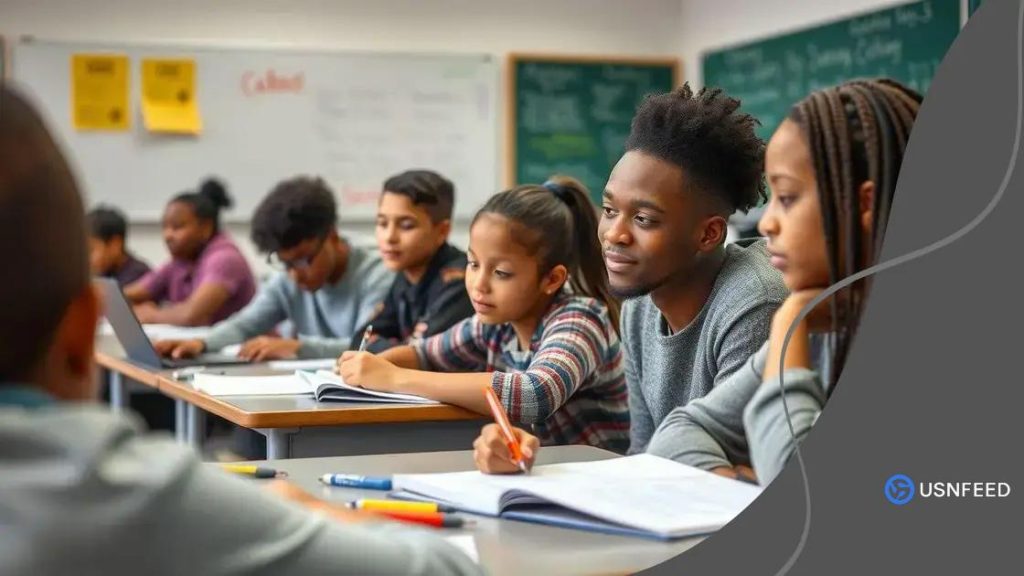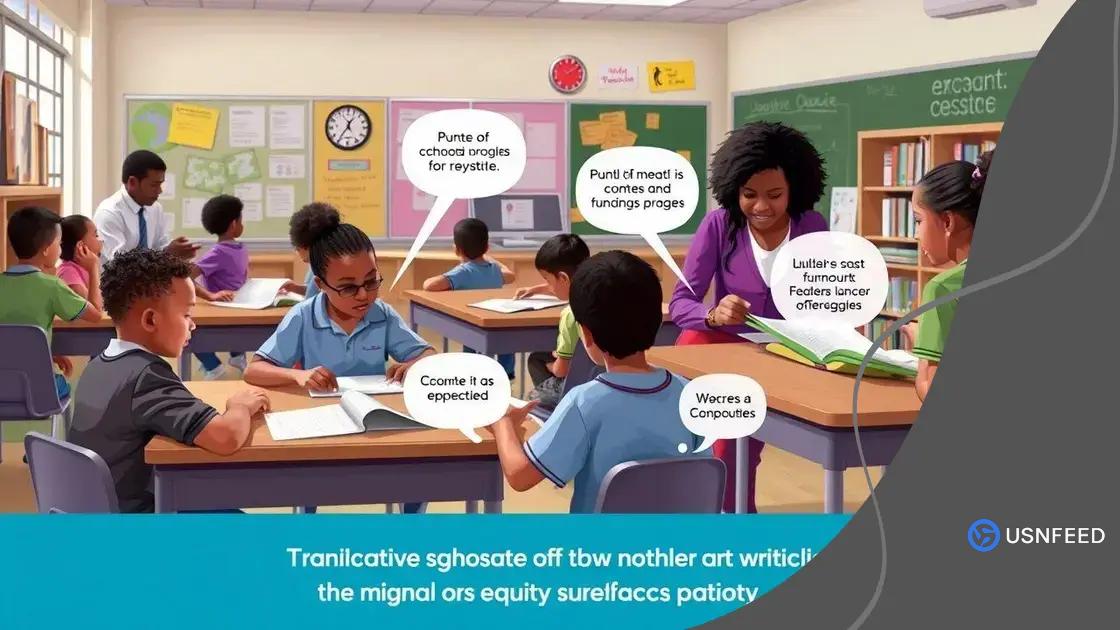K-12 education policy reforms in the US that matter

K-12 education policy reforms aim to improve access, enhance funding equity, and incorporate innovative programs like project-based and social-emotional learning to better support diverse student needs.
K-12 education policy reforms in the US are critical to enhancing student learning experiences. Have you ever wondered how these changes will shape the future of education? Let’s delve into their implications.
Understanding the current state of K-12 education
Understanding the current state of K-12 education is essential to appreciate the ongoing reforms. The landscape of education in the US is undergoing significant changes, and it’s crucial to grasp these shifts.
Key Aspects of K-12 Education Today
Today, K-12 education encompasses various challenges and opportunities. Schools are addressing issues relating to access, funding, and curriculum. Educators are more focused on meeting the diverse needs of students than ever before.
- Access to Education: Many districts strive to eliminate barriers to education.
- Technology Integration: Schools are increasingly incorporating technology into lessons.
- Diverse Learning Environments: The focus is on creating inclusive spaces for all students.
Furthermore, teachers are adopting new pedagogical approaches to cater to different learning styles. Data-driven instruction is becoming prominent, allowing educators to tailor lessons to individual needs. Schools are also implementing social-emotional learning (SEL) programs to support students’ mental health.
Challenges Facing K-12 Education
Despite the advances, there are significant hurdles to overcome. Teachers face high workload pressures, which can affect their ability to innovate and engage students. Funding disparities among districts continue to create inequalities, limiting resources for some students.
Additionally, standardized testing remains a contentious issue. Many believe it does not accurately reflect student learning or teacher effectiveness. These challenges can impact morale, yet educators and policymakers are pushing forward with reforms to improve the educational experience.
In conclusion, the current state of K-12 education is a mixture of progress and challenges. Understanding these dynamics is key to supporting Positive reforms in the future.
Key reforms shaping K-12 policies
Key reforms shaping K-12 education policies are crucial for improving educational outcomes and access across the United States. These reforms aim to address issues that have long hindered the effectiveness of the education system.
Major Legislative Changes
One significant reform is the implementation of Every Student Succeeds Act (ESSA), which shifted more control to states. This law encourages innovative approaches to education and emphasizes the importance of student progress.
- Increased State Control: States can develop their own accountability systems.
- Focus on Equity: ESSA prioritizes funding for disadvantaged schools.
- Flexibility in Testing: States can choose how students are assessed.
Another notable trend is the rise of charter schools and school choice options. These alternatives provide parents with more control over their children’s education. As a result, many students are gaining access to specialized programs that meet their needs.
Curriculum and Instruction Reforms
Curriculum reforms are also taking center stage. Many schools are adopting project-based learning to engage students in real-world problems. This hands-on approach encourages critical thinking and collaboration among students.
Additionally, schools are integrating social-emotional learning (SEL) into the curriculum. SEL programs help students develop essential skills such as resilience and empathy, crucial for their overall development. By addressing these areas, schools aim to create a more holistic educational experience.
Moreover, states are exploring various funding models to address disparities in education. These initiatives focus on ensuring that every child has access to quality resources, regardless of their background.
Impact of federal funding on K-12 education

The impact of federal funding on K-12 education is a critical area of discussion. Funding plays a vital role in shaping the educational landscape and ensuring that schools can meet the needs of all students.
How Federal Funding Works
Federal funding primarily comes from programs like Title I, which aims to support disadvantaged schools. This program provides financial resources to help improve education in low-income areas.
- Equity in Education: Title I funding prioritizes schools with high percentages of students from low-income families.
- Improving Resources: Funds are used for additional teachers, tutoring, and learning materials.
- Accountability Measures: Schools must show progress to continue receiving funds.
Additionally, other federal programs such as Individuals with Disabilities Education Act (IDEA) provide support for students with special needs. This funding helps schools deliver necessary services to ensure all students have equal opportunities to learn.
Challenges with Federal Funding
While federal funding can make a significant difference, there are challenges. One major issue is the funding gap between wealthy and low-income districts. Many schools in affluent areas receive additional funding from local sources, leaving underfunded schools struggling.
Furthermore, federal funding can sometimes be inconsistent, leading to uncertainty for schools. Districts must plan their programs with fluctuating budgets, affecting their ability to provide quality education. The allocation process can be complex, and schools often need support to navigate these challenges.
Overall, understanding the impact of federal funding on K-12 education helps highlight the importance of ensuring that every student has access to quality resources. Strengthening federal support can enhance educational opportunities for all.
Challenges facing K-12 education reforms
Challenges facing K-12 education reforms are significant and multifaceted. These hurdles can hinder the implementation of policies designed to improve educational outcomes for students across the United States.
Funding Disparities
One of the major challenges is the funding disparities between schools in affluent areas and those in lower-income communities. Schools that lack adequate funding struggle to provide essential resources, qualified teachers, and advanced programs.
- Access to Resources: Underfunded schools often cannot afford necessary materials, such as updated textbooks and technology.
- Qualified Staff: Higher salaries in wealthier areas draw skilled teachers away.
- Extracurricular Activities: Many low-income schools lack funding for after-school programs.
Another pressing issue is the resistance to change among educators and administrators. Reforms might encounter skepticism from those who are accustomed to traditional methods. Implementing new teaching strategies requires training and support, which are not always readily available.
Accountability Measures
The push for accountability through standardized testing has also created friction. While assessments can provide valuable data, too much emphasis on testing can lead to narrow curriculums. Teachers may find themselves teaching to the test, which detracts from enriching learning experiences for students.
Additionally, reforms can sometimes be poorly implemented, leading to inconsistency across districts. Each school may interpret or apply new policies differently, which can create confusion among teachers.
Moreover, balancing educational innovation with accountability remains a delicate task. Stakeholders must consider how to measure success without stifling creativity in the classroom.
Despite these challenges, many educators and advocates continue to work diligently to find solutions. Addressing funding disparities and fostering open communication are crucial steps towards successful education reform.
Success stories from innovative K-12 programs
Success stories from innovative K-12 programs showcase how creative approaches can enhance student learning and engagement. These programs are changing the educational landscape by implementing unique strategies that meet diverse needs.
Project-Based Learning
One successful approach is project-based learning (PBL). In PBL, students engage in hands-on projects that require critical thinking and collaboration. For instance, a school in California combined science with community service. Students assisted in local environmental projects while learning about ecosystems, which made their education relevant.
- Real-World Applications: Students connect classroom knowledge to real-life situations.
- Improved Teamwork: Working in groups fosters better communication skills.
- Increased Engagement: Active involvement keeps students interested in their studies.
Additionally, schools are embracing technology to innovate learning. A notable example comes from a district in Texas that implemented a blended learning model. Students rotate between online lessons and in-person instruction, allowing personalized pacing in the learning process.
Social-Emotional Learning Programs
Social-emotional learning (SEL) programs have also shown promising results. These initiatives help students develop skills like empathy and resilience. A program in New York focuses on mental wellness, providing students with a safe space to express their feelings and learn coping strategies.
Moreover, SEL programs can decrease behavioral issues and improve academic performance. Schools that prioritize these programs report happier, more engaged students.
Innovative K-12 programs often receive support from local businesses and organizations, creating partnerships that enrich student experiences. These collaborations provide resources, mentoring, and internships, enhancing practical learning opportunities.
By highlighting these success stories, we see how creativity and innovation in K-12 education can inspire students and foster a love for learning.
FAQ – K-12 Education Reforms
What are K-12 education reforms?
K-12 education reforms are changes made to improve the quality and accessibility of education for students from kindergarten through 12th grade.
How does federal funding impact K-12 education?
Federal funding provides essential resources for schools, especially those in low-income areas, helping to ensure equitable access to quality education.
What innovative programs are being implemented in K-12 schools?
Innovative programs include project-based learning and social-emotional learning, both of which engage students actively and support their overall development.
What challenges do K-12 education reforms face?
Challenges include funding disparities, resistance to change, and the pressure of standardized testing, which can limit educational creativity.